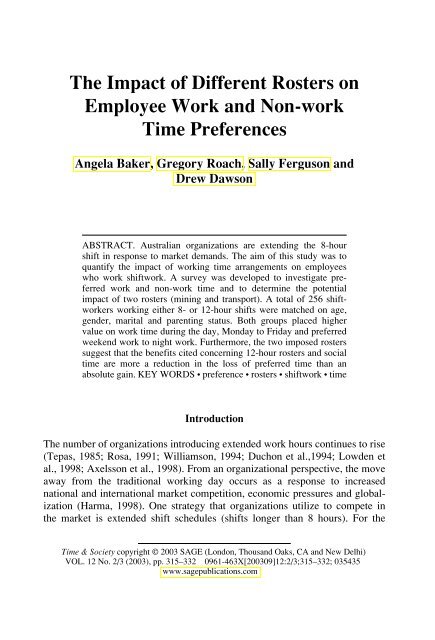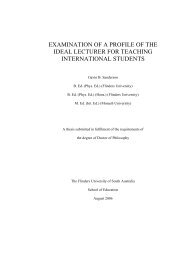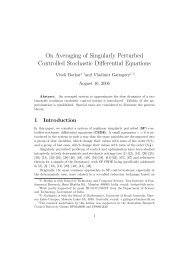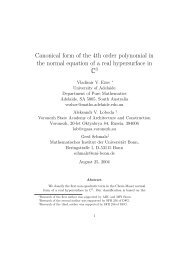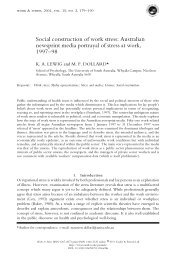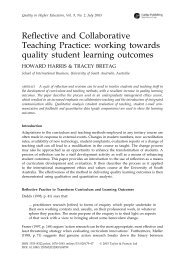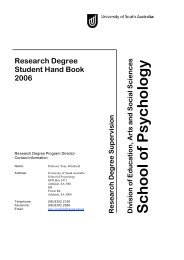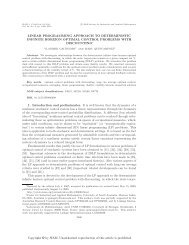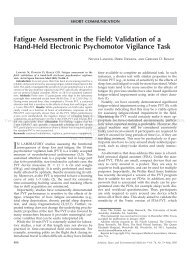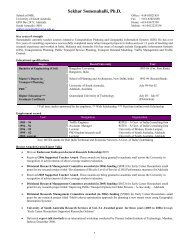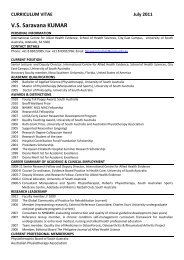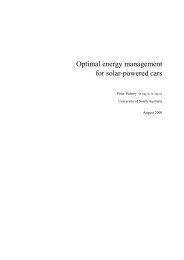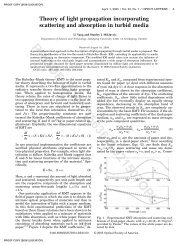The Impact of Different Rosters on Employee Work ... - Study at UniSA
The Impact of Different Rosters on Employee Work ... - Study at UniSA
The Impact of Different Rosters on Employee Work ... - Study at UniSA
Create successful ePaper yourself
Turn your PDF publications into a flip-book with our unique Google optimized e-Paper software.
<str<strong>on</strong>g>The</str<strong>on</strong>g> <str<strong>on</strong>g>Impact</str<strong>on</strong>g> <str<strong>on</strong>g>of</str<strong>on</strong>g> <str<strong>on</strong>g>Different</str<strong>on</strong>g> <str<strong>on</strong>g>Rosters</str<strong>on</strong>g> <strong>on</strong><br />
<strong>Employee</strong> <strong>Work</strong> and N<strong>on</strong>-work<br />
Time Preferences<br />
Angela Baker, Gregory Roach, Sally Fergus<strong>on</strong> and<br />
Drew Daws<strong>on</strong><br />
ABSTRACT. Australian organiz<strong>at</strong>i<strong>on</strong>s are extending the 8-hour<br />
shift in resp<strong>on</strong>se to market demands. <str<strong>on</strong>g>The</str<strong>on</strong>g> aim <str<strong>on</strong>g>of</str<strong>on</strong>g> this study was to<br />
quantify the impact <str<strong>on</strong>g>of</str<strong>on</strong>g> working time arrangements <strong>on</strong> employees<br />
who work shiftwork. A survey was developed to investig<strong>at</strong>e preferred<br />
work and n<strong>on</strong>-work time and to determine the potential<br />
impact <str<strong>on</strong>g>of</str<strong>on</strong>g> two rosters (mining and transport). A total <str<strong>on</strong>g>of</str<strong>on</strong>g> 256 shiftworkers<br />
working either 8- or 12-hour shifts were m<strong>at</strong>ched <strong>on</strong> age,<br />
gender, marital and parenting st<strong>at</strong>us. Both groups placed higher<br />
value <strong>on</strong> work time during the day, M<strong>on</strong>day to Friday and preferred<br />
weekend work to night work. Furthermore, the two imposed rosters<br />
suggest th<strong>at</strong> the benefits cited c<strong>on</strong>cerning 12-hour rosters and social<br />
time are more a reducti<strong>on</strong> in the loss <str<strong>on</strong>g>of</str<strong>on</strong>g> preferred time than an<br />
absolute gain. KEY WORDS • preference • rosters • shiftwork • time<br />
Introducti<strong>on</strong><br />
<str<strong>on</strong>g>The</str<strong>on</strong>g> number <str<strong>on</strong>g>of</str<strong>on</strong>g> organiz<strong>at</strong>i<strong>on</strong>s introducing extended work hours c<strong>on</strong>tinues to rise<br />
(Tepas, 1985; Rosa, 1991; Williams<strong>on</strong>, 1994; Duch<strong>on</strong> et al.,1994; Lowden et<br />
al., 1998; Axelss<strong>on</strong> et al., 1998). From an organiz<strong>at</strong>i<strong>on</strong>al perspective, the move<br />
away from the traditi<strong>on</strong>al working day occurs as a resp<strong>on</strong>se to increased<br />
n<strong>at</strong>i<strong>on</strong>al and intern<strong>at</strong>i<strong>on</strong>al market competiti<strong>on</strong>, ec<strong>on</strong>omic pressures and globaliz<strong>at</strong>i<strong>on</strong><br />
(Harma, 1998). One str<strong>at</strong>egy th<strong>at</strong> organiz<strong>at</strong>i<strong>on</strong>s utilize to compete in<br />
the market is extended shift schedules (shifts l<strong>on</strong>ger than 8 hours). For the<br />
Time & Society copyright © 2003 SAGE (L<strong>on</strong>d<strong>on</strong>, Thousand Oaks, CA and New Delhi)<br />
VOL. 12 No. 2/3 (2003), pp. 315–332 0961-463X[200309]12:2/3;315–332; 035435<br />
www.sagepublic<strong>at</strong>i<strong>on</strong>s.com
316 TIME & SOCIETY 12(2/3)<br />
organiz<strong>at</strong>i<strong>on</strong>, the advantages <str<strong>on</strong>g>of</str<strong>on</strong>g> extended shifts include a reducti<strong>on</strong> in worker<br />
numbers and shift teams, improved communic<strong>at</strong>i<strong>on</strong> <strong>at</strong> shift changeover, reduced<br />
sickness absence, and improved morale and productivity (Lowden et al., 1998;<br />
Gillberg, 1998; Smith et al., 1998; Axelss<strong>on</strong> et al., 1998). However, factors such<br />
as increased sleepiness, impaired performance, high levels <str<strong>on</strong>g>of</str<strong>on</strong>g> f<strong>at</strong>igue and<br />
increased accident/injury r<strong>at</strong>es have also been cited as potential areas <str<strong>on</strong>g>of</str<strong>on</strong>g> c<strong>on</strong>cern<br />
associ<strong>at</strong>ed with extended hours <str<strong>on</strong>g>of</str<strong>on</strong>g> work (Rosa and Colligan, 1989; Budnick et<br />
al., 1994; Axelss<strong>on</strong> et al., 1998; Lowden et al., 1998).<br />
From an employee perspective, the advantages <str<strong>on</strong>g>of</str<strong>on</strong>g> extended work shifts exist<br />
<strong>at</strong> both a pers<strong>on</strong>al and an occup<strong>at</strong>i<strong>on</strong>al level. In additi<strong>on</strong> to the aforementi<strong>on</strong>ed<br />
advantages <str<strong>on</strong>g>of</str<strong>on</strong>g> improved communic<strong>at</strong>i<strong>on</strong> and lower sickness r<strong>at</strong>es, benefits also<br />
include compressi<strong>on</strong> <str<strong>on</strong>g>of</str<strong>on</strong>g> the working week, reduced travelling time and l<strong>on</strong>ger<br />
blocks <str<strong>on</strong>g>of</str<strong>on</strong>g> n<strong>on</strong>-work time (e.g. social, leisure and family time) (Colligan and<br />
Tepas, 1986; Lowden et al., 1998; Rosa and Colligan, 1989; Smith et al., 1998).<br />
Specifically, Smith et al. (1998) suggested th<strong>at</strong> employees working 12-hour<br />
shift c<strong>on</strong>figur<strong>at</strong>i<strong>on</strong>s had access to more free weekends than those working<br />
shorter 8-hour shifts. It has been widely reported th<strong>at</strong> free time <strong>at</strong> weekends and<br />
in the evenings has gre<strong>at</strong>er value than free time during the week (Ernst et al.,<br />
1988; Hornberger and Knauth, 1993; Wedderburn, 1981). This is because the<br />
majority <str<strong>on</strong>g>of</str<strong>on</strong>g> people are involved in other activities such as work, study or school<br />
during the week. Other studies examining the social impact <str<strong>on</strong>g>of</str<strong>on</strong>g> extended workdays<br />
have reported th<strong>at</strong> workers <strong>on</strong> 12-hour shifts were more s<strong>at</strong>isfied with<br />
social aspects <str<strong>on</strong>g>of</str<strong>on</strong>g> their working time arrangements than those working 8-hour<br />
shifts (Jaffe et al., 1996; Lowden et al., 1998). <str<strong>on</strong>g>The</str<strong>on</strong>g> increased s<strong>at</strong>isfacti<strong>on</strong> was<br />
mainly <strong>at</strong>tributed to the l<strong>on</strong>g periods <str<strong>on</strong>g>of</str<strong>on</strong>g> n<strong>on</strong>-work time. Extended work shifts<br />
essentially compress the work week, providing l<strong>on</strong>ger blocks <str<strong>on</strong>g>of</str<strong>on</strong>g> time away from<br />
work. However, extended work shifts may also have adverse effects <strong>on</strong> the<br />
social and family lives <str<strong>on</strong>g>of</str<strong>on</strong>g> shiftworkers and their families. For example, Kundi<br />
and colleagues (Kundi et al., 1995) reported th<strong>at</strong> nurses working 8-hour shifts<br />
were more s<strong>at</strong>isfied than those working 12-hour shifts.<br />
<str<strong>on</strong>g>The</str<strong>on</strong>g> value <str<strong>on</strong>g>of</str<strong>on</strong>g> time appears to be n<strong>on</strong>-transferable across the days <str<strong>on</strong>g>of</str<strong>on</strong>g> the week,<br />
indic<strong>at</strong>ing acceptance <str<strong>on</strong>g>of</str<strong>on</strong>g> the societal norms <str<strong>on</strong>g>of</str<strong>on</strong>g> an evening and weekend society<br />
(Baker et al., 2003; Ernst et al., 1988; Hornberger and Knauth, 1993). This is<br />
reflected in the m<strong>on</strong>etary compens<strong>at</strong>i<strong>on</strong> afforded shiftworkers for working <strong>at</strong><br />
‘socially valuable’ times (<str<strong>on</strong>g>of</str<strong>on</strong>g>ten termed penalty r<strong>at</strong>es). While the payment <str<strong>on</strong>g>of</str<strong>on</strong>g><br />
penalty r<strong>at</strong>es is <strong>on</strong>e way <str<strong>on</strong>g>of</str<strong>on</strong>g> compens<strong>at</strong>ing shiftworkers for the loss <str<strong>on</strong>g>of</str<strong>on</strong>g> socially<br />
valuable time, it may be more beneficial, both for employees and organiz<strong>at</strong>i<strong>on</strong>s,<br />
to reduce the impact <str<strong>on</strong>g>of</str<strong>on</strong>g> working time arrangements through novel and flexible<br />
rostering str<strong>at</strong>egies. However, this would require some qualit<strong>at</strong>ive assessment <str<strong>on</strong>g>of</str<strong>on</strong>g><br />
the social impact (or benefits/costs) <str<strong>on</strong>g>of</str<strong>on</strong>g> work schedules.<br />
<str<strong>on</strong>g>The</str<strong>on</strong>g> benefits and costs associ<strong>at</strong>ed with various working time arrangements<br />
will be dependent <strong>on</strong> a variety <str<strong>on</strong>g>of</str<strong>on</strong>g> factors. <str<strong>on</strong>g>The</str<strong>on</strong>g>se include the employees’ marital
BAKER ET AL.: IMPACT OF DIFFERENT ROSTERS 317<br />
st<strong>at</strong>us (Mott et al., 1965), gender (Gadbois, 1981; Knauth and Costa, 1996), the<br />
number and age <str<strong>on</strong>g>of</str<strong>on</strong>g> dependants (De La Mare and Walker, 1968), the n<strong>at</strong>ure <str<strong>on</strong>g>of</str<strong>on</strong>g><br />
the job (Iskra-Golec et al., 1996), and importantly the specific schedule th<strong>at</strong> <strong>on</strong>e<br />
works (De La Mare and Shimmin, 1964). <strong>Work</strong>ing time arrangements will have<br />
different ‘costs’ or ‘benefits’, which are likely to vary as employees move<br />
through the human life cycle (Hewitt, 1993). Tailoring working time arrangements<br />
to minimize the neg<strong>at</strong>ive impact would have wide-ranging benefits<br />
for employees and employers alike. However, it is currently impractical to<br />
quantify the impact <str<strong>on</strong>g>of</str<strong>on</strong>g> a roster <strong>on</strong> individual employees. Thus, it is generally the<br />
employee who ‘flexes’ r<strong>at</strong>her than the roster.<br />
<str<strong>on</strong>g>The</str<strong>on</strong>g>refore, the first aim was to measure the preferences for work, social, family<br />
and leisure time <str<strong>on</strong>g>of</str<strong>on</strong>g> employees working 8-hour shifts or 12-hour shifts.<br />
Sec<strong>on</strong>dly, the potential impact <str<strong>on</strong>g>of</str<strong>on</strong>g> two different roster schedules <strong>on</strong> employee<br />
time preferences was also quantified.<br />
Do <strong>Employee</strong> Time Preferences Vary with Shift Length?<br />
One hundred and twenty-eight full-time (for 10.9 ± 8.4 years) shiftworkers<br />
working 8-hour shifts and 128 full-time (for 13.8 ± 9.5 years) shiftworkers<br />
working 12-hour shifts were selected from a larger subject popul<strong>at</strong>i<strong>on</strong> c<strong>on</strong>sisting<br />
<str<strong>on</strong>g>of</str<strong>on</strong>g> 763 shiftworkers from a variety <str<strong>on</strong>g>of</str<strong>on</strong>g> Australian organiz<strong>at</strong>i<strong>on</strong>s. Participants<br />
were m<strong>at</strong>ched <strong>on</strong> age (36 ± 9 years), gender, parenting and marital st<strong>at</strong>us. Four<br />
m<strong>at</strong>rices were used to quantify the value <str<strong>on</strong>g>of</str<strong>on</strong>g> time assigned by the employees to<br />
paid work, social, leisure and family time (Baker et al., 2003).<br />
Participants were required to value each hour <str<strong>on</strong>g>of</str<strong>on</strong>g> the day across the seven days<br />
<str<strong>on</strong>g>of</str<strong>on</strong>g> the week <strong>on</strong> a scale from 0 (least preference) to 10 (highest preference) for<br />
each activity. D<strong>at</strong>a were averaged across subjects to produce mean and standard<br />
devi<strong>at</strong>i<strong>on</strong>s for each hour <str<strong>on</strong>g>of</str<strong>on</strong>g> the week, thereby producing a mean m<strong>at</strong>rix for each<br />
employee group for each <str<strong>on</strong>g>of</str<strong>on</strong>g> the four activities. <str<strong>on</strong>g>The</str<strong>on</strong>g> mean scores indic<strong>at</strong>e the<br />
times in the week th<strong>at</strong> are c<strong>on</strong>sidered <str<strong>on</strong>g>of</str<strong>on</strong>g> gre<strong>at</strong>est or least importance for particular<br />
activities. <str<strong>on</strong>g>The</str<strong>on</strong>g> mean scores are represented by c<strong>on</strong>tour maps, using shading<br />
to depict different preference levels.<br />
Activity definiti<strong>on</strong>s<br />
Preferred work time referred to ‘time you would prefer to work in your main<br />
area <str<strong>on</strong>g>of</str<strong>on</strong>g> paid employment across the week, irrespective <str<strong>on</strong>g>of</str<strong>on</strong>g> current work p<strong>at</strong>terns’.<br />
Preferred social time referred to ‘time you would prefer to spend with family<br />
and friends involved in fun and entertainment, e<strong>at</strong>ing, drinking and social life<br />
activities’ (Argyle, 1996).<br />
Preferred leisure time referred to ‘time you would prefer to spend doing those
318 TIME & SOCIETY 12(2/3)<br />
activities th<strong>at</strong> you do in your free time, because you want to, for their own sake,<br />
for fun, entertainment, self-improvement or for goals <str<strong>on</strong>g>of</str<strong>on</strong>g> your own choosing but<br />
not for m<strong>at</strong>erial gain’ (Argyle, 1996).<br />
Preferred family time referred to ‘time you spent with your partner, spouse,<br />
child(ren) and/or other family members involved in school or sporting activities,<br />
fun and entertainment, home duty situ<strong>at</strong>i<strong>on</strong>s, time <strong>at</strong> home etc.’ (Argyle,<br />
1996).<br />
Comparis<strong>on</strong> <str<strong>on</strong>g>of</str<strong>on</strong>g> different shift schedules<br />
<str<strong>on</strong>g>The</str<strong>on</strong>g> grid system represented a dimensi<strong>on</strong>aliz<strong>at</strong>i<strong>on</strong> <str<strong>on</strong>g>of</str<strong>on</strong>g> a 168-hour time sequence<br />
into a 7 × 24-hour time sequence; thus the values for work, social, leisure and<br />
family are not independent observ<strong>at</strong>i<strong>on</strong>s. <str<strong>on</strong>g>The</str<strong>on</strong>g>refore, it would be inappropri<strong>at</strong>e to<br />
quote a multivari<strong>at</strong>e st<strong>at</strong>istic (for example, Hottelling’s T or Roy’s Gre<strong>at</strong>est<br />
Root) due to m<strong>at</strong>rix singularity. To address the large number <str<strong>on</strong>g>of</str<strong>on</strong>g> dependent variables<br />
and to c<strong>on</strong>trol for the probability <str<strong>on</strong>g>of</str<strong>on</strong>g> a type-I error, an ad hoc technique was<br />
adopted. Significance was imposed <strong>at</strong> p < .01, with a further requirement <str<strong>on</strong>g>of</str<strong>on</strong>g> <strong>at</strong><br />
least two c<strong>on</strong>tiguous cells, either vertical or horiz<strong>on</strong>tal, to be c<strong>on</strong>sidered. Hence,<br />
multiple t-tests were employed to provide comparis<strong>on</strong>s across the hours <str<strong>on</strong>g>of</str<strong>on</strong>g> the<br />
day, for each day <str<strong>on</strong>g>of</str<strong>on</strong>g> the week, for each key area, to determine significant differences<br />
between groups.<br />
<strong>Work</strong> time<br />
<str<strong>on</strong>g>The</str<strong>on</strong>g> 8-hour employee group preferred not to be engaged in paid work from<br />
approxim<strong>at</strong>ely midnight to dawn any day. In c<strong>on</strong>trast, the 12-hour group<br />
indic<strong>at</strong>ed preference scores above zero for all times across the week (Figure 1a<br />
and 1b). Figure 2 shows the differences in work time preferences between<br />
employees working 8-hour shifts and employees working 12-hour shifts.<br />
<strong>Employee</strong>s working 12-hour shifts had significantly higher preferences for<br />
work in the early morning hours.<br />
Social time<br />
<str<strong>on</strong>g>The</str<strong>on</strong>g> highest preference for social time was <strong>at</strong> the weekends in the evenings for<br />
both groups (Figure 3a and 3b). However, the 12-hour group had significantly<br />
higher preferences for social time in the early morning and into the midafterno<strong>on</strong><br />
<strong>on</strong> weekdays than the 8-hour group (Figure 4). Although the preferences<br />
<str<strong>on</strong>g>of</str<strong>on</strong>g> the 12-hour group were quite low (2–3) <strong>at</strong> these times, they were<br />
significantly higher than the 8-hour group.<br />
Leisure time<br />
Both groups had the gre<strong>at</strong>est preference for leisure time in the<br />
afterno<strong>on</strong>s/evenings <str<strong>on</strong>g>of</str<strong>on</strong>g> Friday, S<strong>at</strong>urday and Sunday (Figure 5a and 5b). Again,
BAKER ET AL.: IMPACT OF DIFFERENT ROSTERS 319<br />
M<strong>on</strong><br />
Tue<br />
Wed<br />
Thu<br />
Fri<br />
S<strong>at</strong><br />
Sun<br />
0 1 2 3 4 5 6 7 8 9 10 11 12 13 14 15 16 17 18 19 20 21 22 23<br />
M<strong>on</strong><br />
Tue<br />
Wed<br />
Thu<br />
Fri<br />
S<strong>at</strong><br />
Day <str<strong>on</strong>g>of</str<strong>on</strong>g> the week<br />
9–10<br />
8–9<br />
7–8<br />
6–7<br />
5–6<br />
4–5<br />
3–4<br />
2–3<br />
1–2<br />
0–1<br />
Sun<br />
0 1 2 3 4 5 6 7 8 9 10 11 12 13 14 15 16 17 18 19 20 21 22 23<br />
Hour <str<strong>on</strong>g>of</str<strong>on</strong>g> the day<br />
FIGURE 1<br />
C<strong>on</strong>tour maps indic<strong>at</strong>ing the preferred working time for employees working<br />
8-hour shifts (top panel) and 12-hour shifts (lower panel)<br />
0000 0400 0800 1200 1600 2000<br />
M<strong>on</strong><br />
Tue<br />
Wed<br />
Thur<br />
Fri<br />
S<strong>at</strong><br />
Sun<br />
Day <str<strong>on</strong>g>of</str<strong>on</strong>g> the week<br />
Hour <str<strong>on</strong>g>of</str<strong>on</strong>g> the day<br />
FIGURE 2<br />
<str<strong>on</strong>g>The</str<strong>on</strong>g> difference in work time preferences for employees working 8-hour shifts and<br />
employees working 12-hour shifts. <str<strong>on</strong>g>The</str<strong>on</strong>g> dark grey area indic<strong>at</strong>es the time <str<strong>on</strong>g>of</str<strong>on</strong>g> the<br />
week th<strong>at</strong> 12-hour employees indic<strong>at</strong>ed higher preferences than 8-hour employees
320 TIME & SOCIETY 12(2/3)<br />
M<strong>on</strong><br />
Tue<br />
Wed<br />
Thu<br />
Fri<br />
S<strong>at</strong><br />
Sun<br />
0 1 2 3 4 5 6 7 8 9 10 11 12 13 14 15 16 17 18 19 20 21 22 23<br />
M<strong>on</strong><br />
Tue<br />
Wed<br />
Thu<br />
Fri<br />
S<strong>at</strong><br />
Sun<br />
0 1 2 3 4 5 6 7 8 9 10 11 12 13 14 15 16 17 18 19 20 21 22 23<br />
Hour <str<strong>on</strong>g>of</str<strong>on</strong>g> the day<br />
Day <str<strong>on</strong>g>of</str<strong>on</strong>g> the week<br />
9–10<br />
8–9<br />
7–8<br />
6–7<br />
5–6<br />
4–5<br />
3–4<br />
2–3<br />
1–2<br />
0–1<br />
FIGURE 3<br />
C<strong>on</strong>tour maps indic<strong>at</strong>ing the preferred social time for employees working 8-hour<br />
shifts (top panel) and 12-hour shifts (lower panel)<br />
M<strong>on</strong><br />
Tue<br />
Wed<br />
Thur<br />
Fri<br />
S<strong>at</strong><br />
Sun<br />
Day <str<strong>on</strong>g>of</str<strong>on</strong>g> the week<br />
0000 0400 0800 1200 1600 2000<br />
Hour <str<strong>on</strong>g>of</str<strong>on</strong>g> the day<br />
FIGURE 4<br />
<str<strong>on</strong>g>The</str<strong>on</strong>g> difference in social time preferences for employees working 8-hour shifts and<br />
employees working 12-hour shifts. <str<strong>on</strong>g>The</str<strong>on</strong>g> darker grey area indic<strong>at</strong>es the time <str<strong>on</strong>g>of</str<strong>on</strong>g> the<br />
week th<strong>at</strong> 12-hour employees indic<strong>at</strong>ed higher preferences than 8-hour employees
BAKER ET AL.: IMPACT OF DIFFERENT ROSTERS 321<br />
the 12-hour group had significantly higher preferences for leisure in the early<br />
morning hours, in additi<strong>on</strong> to the early afterno<strong>on</strong>s <str<strong>on</strong>g>of</str<strong>on</strong>g> weekdays (Figure 6).<br />
Family time<br />
<str<strong>on</strong>g>The</str<strong>on</strong>g> 8-hour group had the highest preference for family time <strong>on</strong> S<strong>at</strong>urday<br />
evening, similar to the 12-hour group (Figure 7a and 7b). <str<strong>on</strong>g>The</str<strong>on</strong>g> 12-hour shiftworkers<br />
valued family time significantly higher than the 8-hour shiftworkers<br />
throughout the early mornings Friday, S<strong>at</strong>urday and Sunday (Figure 8).<br />
<str<strong>on</strong>g>The</str<strong>on</strong>g> 12-hour group generally indic<strong>at</strong>ed a wider range <str<strong>on</strong>g>of</str<strong>on</strong>g> times th<strong>at</strong> they were<br />
prepared to use for n<strong>on</strong>-work activities. <str<strong>on</strong>g>The</str<strong>on</strong>g>y appear to r<strong>at</strong>e all hours <str<strong>on</strong>g>of</str<strong>on</strong>g> the<br />
week as potentially valuable, while 8-hour employees do not r<strong>at</strong>e the midnight<br />
to dawn hours <strong>at</strong> all.<br />
Does the <str<strong>on</strong>g>Impact</str<strong>on</strong>g> <str<strong>on</strong>g>of</str<strong>on</strong>g> <strong>Work</strong> Vary with Shift Length?<br />
<str<strong>on</strong>g>The</str<strong>on</strong>g> potential psychosocial impact <str<strong>on</strong>g>of</str<strong>on</strong>g> work schedules was quantified using two<br />
actual work rosters, <strong>on</strong>e involving 8-hour shifts and <strong>on</strong>e involving 12-hour<br />
shifts. <str<strong>on</strong>g>The</str<strong>on</strong>g> rosters were chosen as real-world examples <str<strong>on</strong>g>of</str<strong>on</strong>g> 8-hour and 12-hour<br />
roster systems, used comm<strong>on</strong>ly in Australian transport and mining industries<br />
respectively. <str<strong>on</strong>g>The</str<strong>on</strong>g> schedules <str<strong>on</strong>g>of</str<strong>on</strong>g> the transport and mining rosters were superimposed<br />
over the mean time value m<strong>at</strong>rices (work, social, family and leisure) <str<strong>on</strong>g>of</str<strong>on</strong>g><br />
the 8-hour and 12-hour shiftworking groups. An example <str<strong>on</strong>g>of</str<strong>on</strong>g> the procedure is<br />
depicted in Figures 9–10. <str<strong>on</strong>g>The</str<strong>on</strong>g> scores in each block corresp<strong>on</strong>ding to the<br />
rostered work hours were summed to produce a score for work, social, leisure<br />
and family time for each shiftwork group for both rosters.<br />
<str<strong>on</strong>g>The</str<strong>on</strong>g> impact <str<strong>on</strong>g>of</str<strong>on</strong>g> the transport (8H) and mining (12H) rosters was determined<br />
rel<strong>at</strong>ive to the impact <str<strong>on</strong>g>of</str<strong>on</strong>g> a standard roster (0900h – 1700h, M<strong>on</strong>day–Friday<br />
week). As the ‘standard’ working week schedule is essentially the benchmark<br />
by which penalty r<strong>at</strong>es are determined, the standard score was used as a reference<br />
point to compare the impact <str<strong>on</strong>g>of</str<strong>on</strong>g> the 8H and 12H rosters. A move away from<br />
the standard score was dem<strong>on</strong>str<strong>at</strong>ed by either a gain or loss <str<strong>on</strong>g>of</str<strong>on</strong>g> preference<br />
points, representing a ‘benefit’ or ‘cost’ to the employee.<br />
Preferred work time scores<br />
<str<strong>on</strong>g>The</str<strong>on</strong>g> scores alloc<strong>at</strong>ed by participants for work time represented the hours <str<strong>on</strong>g>of</str<strong>on</strong>g> the<br />
day the participant preferred to work. Access to preferred work time was<br />
c<strong>on</strong>sidered a ‘benefit’ to employees. Thus, the more hours in the roster th<strong>at</strong><br />
coincided with high preference points the more beneficial the roster, and the<br />
higher the score.
322 TIME & SOCIETY 12(2/3)<br />
M<strong>on</strong><br />
Tue<br />
Wed<br />
Thu<br />
Fri<br />
S<strong>at</strong><br />
Sun<br />
0 1 2 3 4 5 6 7 8 9 10 11 12 13 14 15 16 17 18 19 20 21 22 23<br />
M<strong>on</strong><br />
Tue<br />
Wed<br />
Thu<br />
Fri<br />
S<strong>at</strong><br />
Sun<br />
0 1 2 3 4 5 6 7 8 9 10 11 12 13 14 15 16 17 18 19 20 21 22 23<br />
Day <str<strong>on</strong>g>of</str<strong>on</strong>g> the week<br />
9–10<br />
8–9<br />
7–8<br />
6–7<br />
5–6<br />
4–5<br />
3–4<br />
2–3<br />
1–2<br />
0–1<br />
Hour <str<strong>on</strong>g>of</str<strong>on</strong>g> the day<br />
FIGURE 5<br />
C<strong>on</strong>tour maps indic<strong>at</strong>ing the preferred leisure time for employees working 8-hour<br />
shifts (top panel) and 12-hour shifts (lower panel)<br />
0000 0400<br />
0800<br />
1200<br />
1600<br />
2000<br />
0000 0400 0800 1200 1600 2000<br />
Hour <str<strong>on</strong>g>of</str<strong>on</strong>g> the day<br />
M<strong>on</strong><br />
Tues<br />
Wed<br />
Thur<br />
Fri<br />
S<strong>at</strong><br />
Sun<br />
M<strong>on</strong><br />
Tue<br />
Wed<br />
Thur<br />
Fri<br />
S<strong>at</strong><br />
Sun<br />
Day <str<strong>on</strong>g>of</str<strong>on</strong>g> the week<br />
FIGURE 6<br />
<str<strong>on</strong>g>The</str<strong>on</strong>g> difference in leisure time preferences for employees working 8-hour shifts and<br />
employees working 12-hour shifts. <str<strong>on</strong>g>The</str<strong>on</strong>g> darker grey area indic<strong>at</strong>es the time <str<strong>on</strong>g>of</str<strong>on</strong>g> the<br />
week th<strong>at</strong> 12-hour employees indic<strong>at</strong>ed higher preferences than 8-hour employees
BAKER ET AL.: IMPACT OF DIFFERENT ROSTERS 323<br />
M<strong>on</strong><br />
Tue<br />
Wed<br />
Thu<br />
Fri<br />
S<strong>at</strong><br />
Sun<br />
0 1 2 3 4 5 6 7 8 9 10 11 12 13 14 15 16 17 18 19 20 21 22 23<br />
M<strong>on</strong><br />
Tue<br />
Wed<br />
Thu<br />
Fri<br />
S<strong>at</strong><br />
Sun<br />
0 1 2 3 4 5 6 7 8 9 10 11 12 13 14 15 16 17 18 19 20 21 22 23<br />
Day <str<strong>on</strong>g>of</str<strong>on</strong>g> the week<br />
9–10<br />
8–9<br />
7–8<br />
6–7<br />
5–6<br />
4–5<br />
3–4<br />
2–3<br />
1–2<br />
0–1<br />
Hour <str<strong>on</strong>g>of</str<strong>on</strong>g> the day<br />
FIGURE 7<br />
C<strong>on</strong>tour maps indic<strong>at</strong>ing the preferred family time for employees working 8-hour<br />
shifts (top panel) and 12-hour shifts (lower panel)<br />
0000 0400<br />
0800<br />
1200<br />
1600<br />
2000<br />
0000 0400 0800 1200 1600 2000<br />
Hour <str<strong>on</strong>g>of</str<strong>on</strong>g> the day<br />
M<strong>on</strong><br />
Tues<br />
Wed<br />
Thur<br />
Fri<br />
S<strong>at</strong><br />
Sun<br />
Day <str<strong>on</strong>g>of</str<strong>on</strong>g> the week<br />
FIGURE 8<br />
<str<strong>on</strong>g>The</str<strong>on</strong>g> difference in family time preferences for employees working 8-hour shifts and<br />
employees working 12-hour shifts. <str<strong>on</strong>g>The</str<strong>on</strong>g> dark grey area indic<strong>at</strong>es the time <str<strong>on</strong>g>of</str<strong>on</strong>g> the<br />
week th<strong>at</strong> 12-hour employees indic<strong>at</strong>ed higher preferences than 8-hour employees
324 TIME & SOCIETY 12(2/3)<br />
FIGURE 9<br />
<str<strong>on</strong>g>The</str<strong>on</strong>g> transport roster imposed across the 24-hour day and a 7-week cycle using the<br />
mean preference scores for preferred work time (shaded areas represent hours<br />
worked).
BAKER ET AL.: IMPACT OF DIFFERENT ROSTERS 325<br />
FIGURE 10<br />
<str<strong>on</strong>g>The</str<strong>on</strong>g> mining roster imposed across the 24-hour day and a 7-week cycle using the<br />
mean preference points for preferred work time (shaded areas represent hours<br />
worked)
326 TIME & SOCIETY 12(2/3)<br />
Preferred n<strong>on</strong>-work time scores<br />
<str<strong>on</strong>g>The</str<strong>on</strong>g> n<strong>on</strong>-work scores were determined by superimposing the roster schedules<br />
over the leisure, family and social m<strong>at</strong>rices. <str<strong>on</strong>g>The</str<strong>on</strong>g> gre<strong>at</strong>er the scores obtained by<br />
summing the preference scores in the roster blocks, the gre<strong>at</strong>er the preference for<br />
n<strong>on</strong>-work activities in those work periods. Thus, a requirement to work during a<br />
period highly valued for social, leisure or family time represented a cost.<br />
Determining the impact <str<strong>on</strong>g>of</str<strong>on</strong>g> different shift schedules<br />
<str<strong>on</strong>g>The</str<strong>on</strong>g> transport roster (8H) represented a cost for employees working 8-hour days<br />
in terms <str<strong>on</strong>g>of</str<strong>on</strong>g> work time. An average reducti<strong>on</strong> (cost) in preferred paid work time<br />
<str<strong>on</strong>g>of</str<strong>on</strong>g> 40.7% was found for this group, as compared to the Standard roster (Figure<br />
11). For preferred social time, a reducti<strong>on</strong> <str<strong>on</strong>g>of</str<strong>on</strong>g> approxim<strong>at</strong>ely 89.5% was found<br />
for the 8-hour employees and preferred leisure time was reduced by an average<br />
<str<strong>on</strong>g>of</str<strong>on</strong>g> approxim<strong>at</strong>ely 35.3% (Figure 11). <str<strong>on</strong>g>The</str<strong>on</strong>g> score associ<strong>at</strong>ed with preferred family<br />
time was 26.7% lower than the score associ<strong>at</strong>ed with the standard roster<br />
(Figure 11).<br />
<str<strong>on</strong>g>The</str<strong>on</strong>g> potential scores for work, social, leisure and family time <str<strong>on</strong>g>of</str<strong>on</strong>g> the 8-hour<br />
employees were also calcul<strong>at</strong>ed for the mining roster (12H). If the 8-hour<br />
employee group worked the mining roster, preferred work time would be<br />
reduced by 47% compared to the standard roster. Similarly, both preferred<br />
social time (68.6%) and preferred leisure time (18.4%) were reduced compared<br />
to the standard roster. Overall, there would be <strong>on</strong>ly a 9.9% decrease in preferred<br />
family time for 8-hour employees if they were to work the mining roster (12H)<br />
(Figure 11).<br />
<str<strong>on</strong>g>The</str<strong>on</strong>g>refore, for employees regularly working an 8-hour shift system, both<br />
potential roster scenarios impacted most significantly <strong>on</strong> their preferred social<br />
time. Interestingly, the 8H roster schedule represented the highest cost in terms<br />
<str<strong>on</strong>g>of</str<strong>on</strong>g> preferred social time for employees currently working an 8-hour schedule.<br />
If the 12-hour employee group were to work the transport (8H day) roster,<br />
they would incur an average reducti<strong>on</strong> in preferred paid work time <str<strong>on</strong>g>of</str<strong>on</strong>g> approxim<strong>at</strong>ely<br />
35.2% compared with the standard score (Figure 11). For preferred<br />
social time, a reducti<strong>on</strong> <str<strong>on</strong>g>of</str<strong>on</strong>g> 22.2% was found for the 12-hour employees and<br />
14.9% reducti<strong>on</strong> in preferred leisure time. Preferred family time was also<br />
reduced across the 12-hour employee popul<strong>at</strong>i<strong>on</strong> by 22.7%.<br />
If the 12-hour employees were to work the mining roster, they would experience<br />
an average reducti<strong>on</strong> in preferred work time <str<strong>on</strong>g>of</str<strong>on</strong>g> 40.2%. Further, preferred<br />
social time was reduced by 12.5%, and preferred leisure time by <strong>on</strong>ly 5.8%. For<br />
preferred family time the mining roster represented a cost <str<strong>on</strong>g>of</str<strong>on</strong>g> 11.4% for employees<br />
currently working 12-hour shifts compared with the standard score (Figure<br />
11).
BAKER ET AL.: IMPACT OF DIFFERENT ROSTERS 327<br />
100<br />
80<br />
<strong>Work</strong><br />
100<br />
80<br />
Social<br />
60<br />
60<br />
40<br />
40<br />
20<br />
20<br />
0<br />
8-hour<br />
12-hour<br />
0<br />
8-hour<br />
12-hour<br />
100<br />
80<br />
Leisure<br />
100<br />
80<br />
Family<br />
60<br />
60<br />
40<br />
40<br />
20<br />
20<br />
0<br />
8-hour<br />
12-hour<br />
0<br />
8-hour<br />
12-hour<br />
FIGURE 11<br />
<str<strong>on</strong>g>The</str<strong>on</strong>g> impact <str<strong>on</strong>g>of</str<strong>on</strong>g> the 8-hour roster (white bars) or the 12-hour roster (grey bars) <strong>on</strong><br />
the time preferences <str<strong>on</strong>g>of</str<strong>on</strong>g> employees regularly working 8-hour shifts or 12-hour<br />
shifts. <str<strong>on</strong>g>The</str<strong>on</strong>g> y-axis depicts the percentage change in score compared to the impact <str<strong>on</strong>g>of</str<strong>on</strong>g><br />
a standard, 40-hour week. <str<strong>on</strong>g>The</str<strong>on</strong>g> x-axis represents the employee group<br />
<str<strong>on</strong>g>The</str<strong>on</strong>g>refore, for employees currently engaged in a 12-hour work shift system,<br />
the gre<strong>at</strong>est cost <str<strong>on</strong>g>of</str<strong>on</strong>g> both an 8H and 12H system was evident in the preferred<br />
work time. Interestingly, the neg<strong>at</strong>ive impact <strong>on</strong> preferred social and leisure<br />
time <str<strong>on</strong>g>of</str<strong>on</strong>g> the two roster scenarios (8H and 12H) for the 12-hour group was half<br />
th<strong>at</strong> <str<strong>on</strong>g>of</str<strong>on</strong>g> the 8-hour group.<br />
C<strong>on</strong>clusi<strong>on</strong>s<br />
This article dem<strong>on</strong>str<strong>at</strong>es th<strong>at</strong> it is possible to objectively quantify the potential<br />
impact <str<strong>on</strong>g>of</str<strong>on</strong>g> a working time arrangement <strong>on</strong> the preferred work, social, leisure and<br />
family time <str<strong>on</strong>g>of</str<strong>on</strong>g> a group <str<strong>on</strong>g>of</str<strong>on</strong>g> employees. <str<strong>on</strong>g>The</str<strong>on</strong>g> way employees value time varies<br />
depending <strong>on</strong> their regular working time arrangements. <str<strong>on</strong>g>The</str<strong>on</strong>g> results provide an<br />
avenue through which the development <str<strong>on</strong>g>of</str<strong>on</strong>g> more sophistic<strong>at</strong>ed d<strong>at</strong>a analysis
328 TIME & SOCIETY 12(2/3)<br />
techniques may ultim<strong>at</strong>ely make it practical for organiz<strong>at</strong>i<strong>on</strong>s to tailor roster<br />
schedules to minimize the adverse impact <strong>on</strong> employees’ lives.<br />
Our previous report indic<strong>at</strong>ed th<strong>at</strong> employees working a ‘normal’ day shift<br />
(M<strong>on</strong>day to Friday, 9am–5pm) had different time preferences for work and<br />
social time compared to employees working shiftwork (Baker et al., 2003). As<br />
an extensi<strong>on</strong> <str<strong>on</strong>g>of</str<strong>on</strong>g> these findings the current study examined the time valu<strong>at</strong>i<strong>on</strong> <str<strong>on</strong>g>of</str<strong>on</strong>g><br />
shiftworkers working different types <str<strong>on</strong>g>of</str<strong>on</strong>g> shiftwork (8-hour shifts versus 12-hour<br />
shifts). Shiftworkers working 8- and 12-hour shifts both indic<strong>at</strong>ed a peak<br />
preference for work during the daylight hours from M<strong>on</strong>day to Friday. <str<strong>on</strong>g>The</str<strong>on</strong>g> peak<br />
preferred working times were c<strong>on</strong>sistent with the dominant societal norm <str<strong>on</strong>g>of</str<strong>on</strong>g> an<br />
evening and weekend society (Baker et al., 2003; Hornberger and Knauth,<br />
1993). However, the peak preference times for shiftworkers working 12-hour<br />
shifts extended to an earlier start in the morning and a l<strong>at</strong>er finish in the afterno<strong>on</strong>,<br />
compared to 8-hour shiftworkers. In additi<strong>on</strong>, while the preference scores<br />
for work across the night/early morning hours (midnight – 0600h) were low for<br />
both groups, the 12-hour shiftworkers had a significantly higher score over this<br />
period.<br />
<strong>Employee</strong>s currently working 12-hour shifts c<strong>on</strong>sidered any time <str<strong>on</strong>g>of</str<strong>on</strong>g> the day<br />
or night acceptable for n<strong>on</strong>-work activities. This finding supports previous<br />
research showing th<strong>at</strong> shiftworkers selected activities outside <str<strong>on</strong>g>of</str<strong>on</strong>g> the workplace<br />
th<strong>at</strong> were time flexible, and in many cases individual, r<strong>at</strong>her than groupdetermined<br />
(Blakelock, 1960). <str<strong>on</strong>g>The</str<strong>on</strong>g> 12-hour shiftworker group viewed all hours<br />
across the week as potentially more valuable than did the 8-hour group. <str<strong>on</strong>g>The</str<strong>on</strong>g><br />
questi<strong>on</strong> remains however: do employees who are accustomed to working<br />
extended shifts c<strong>on</strong>sequently have a wider preference for time, or do they work<br />
extended shifts because they have a broader range <str<strong>on</strong>g>of</str<strong>on</strong>g> time preferences?<br />
Individuals who work <strong>at</strong> times <str<strong>on</strong>g>of</str<strong>on</strong>g> social high value are generally compens<strong>at</strong>ed<br />
financially (Allan et al., 1998). However, as more organiz<strong>at</strong>i<strong>on</strong>s now oper<strong>at</strong>e <strong>on</strong><br />
a 24-hour basis, compens<strong>at</strong>i<strong>on</strong> may become increasingly redundant if the value<br />
<str<strong>on</strong>g>of</str<strong>on</strong>g> time is no l<strong>on</strong>ger differenti<strong>at</strong>ed across the hours <str<strong>on</strong>g>of</str<strong>on</strong>g> the day and/or the days <str<strong>on</strong>g>of</str<strong>on</strong>g><br />
the week. <str<strong>on</strong>g>The</str<strong>on</strong>g> current findings do not support such a trend. R<strong>at</strong>her, in line with<br />
previous findings, the d<strong>at</strong>a suggest th<strong>at</strong> the value <str<strong>on</strong>g>of</str<strong>on</strong>g> time remains dispar<strong>at</strong>e<br />
across the week, irrespective <str<strong>on</strong>g>of</str<strong>on</strong>g> the system <str<strong>on</strong>g>of</str<strong>on</strong>g> work. <str<strong>on</strong>g>The</str<strong>on</strong>g> standard working week<br />
c<strong>on</strong>tinues to be perceived as a marker for working time, despite the fact th<strong>at</strong> it<br />
may be increasingly out <str<strong>on</strong>g>of</str<strong>on</strong>g> step with the occup<strong>at</strong>i<strong>on</strong>al and ec<strong>on</strong>omic changes <str<strong>on</strong>g>of</str<strong>on</strong>g><br />
society (Bittman and Pixley, 1997; Levine and Pittinsky, 1997).<br />
<str<strong>on</strong>g>The</str<strong>on</strong>g> potential impact <str<strong>on</strong>g>of</str<strong>on</strong>g> different roster schedules <strong>on</strong> the work and n<strong>on</strong>-work<br />
time <str<strong>on</strong>g>of</str<strong>on</strong>g> employees was assessed quantit<strong>at</strong>ively. <str<strong>on</strong>g>The</str<strong>on</strong>g> change from <strong>on</strong>e roster to<br />
another is known to take c<strong>on</strong>siderable time and can be a difficult organiz<strong>at</strong>i<strong>on</strong>al<br />
process (Baker et al., 1997). For employees working 8-hour shifts, the overall<br />
impact <str<strong>on</strong>g>of</str<strong>on</strong>g> the mining roster (12-hour shifts) was less than the overall impact <str<strong>on</strong>g>of</str<strong>on</strong>g><br />
the transport roster (8-hour shifts). <str<strong>on</strong>g>The</str<strong>on</strong>g> majority <str<strong>on</strong>g>of</str<strong>on</strong>g> workers would have experi-
BAKER ET AL.: IMPACT OF DIFFERENT ROSTERS 329<br />
enced a reducti<strong>on</strong> in each <str<strong>on</strong>g>of</str<strong>on</strong>g> the preferred activity times when compared to the<br />
M<strong>on</strong>day to Friday work schedule; however, the ‘costs’ were generally lower for<br />
the mining roster (12H) than the transport roster (8H). Thus, the benefits <str<strong>on</strong>g>of</str<strong>on</strong>g>ten<br />
cited in associ<strong>at</strong>i<strong>on</strong> with 12-hour shifts may not necessarily be an outright gain<br />
in preferred time, but r<strong>at</strong>her a reducti<strong>on</strong> in the ‘costs’. <str<strong>on</strong>g>The</str<strong>on</strong>g> mining roster reflected<br />
more <str<strong>on</strong>g>of</str<strong>on</strong>g> the preferred family time than the transport roster. <str<strong>on</strong>g>The</str<strong>on</strong>g> ‘benefits’<br />
may be due to the l<strong>on</strong>ger breaks away from the workplace r<strong>at</strong>her than the<br />
availability <str<strong>on</strong>g>of</str<strong>on</strong>g> ‘free’ time when working <strong>on</strong> a day-to-day basis.<br />
Overall, employees working 12-hour shifts would have experienced a reducti<strong>on</strong><br />
in access to preferred activity times <strong>on</strong> both the mining (12H) and transport<br />
(8H) rosters. In both roster schedules, the gre<strong>at</strong>est reducti<strong>on</strong> in percentage<br />
points was found for preferred working time when compared to the standard<br />
working week. This is not surprising as shiftworkers indic<strong>at</strong>e preferred working<br />
times th<strong>at</strong> parallel the standard working week (Baker et al., 2003).<br />
As a result <str<strong>on</strong>g>of</str<strong>on</strong>g> the m<strong>at</strong>ching <str<strong>on</strong>g>of</str<strong>on</strong>g> subjects <strong>on</strong> factors such as parenting and marital<br />
st<strong>at</strong>us, there were <strong>on</strong>ly 10 females in the shiftwork popul<strong>at</strong>i<strong>on</strong>s, compared<br />
with 118 males. <str<strong>on</strong>g>The</str<strong>on</strong>g> gender divisi<strong>on</strong> <str<strong>on</strong>g>of</str<strong>on</strong>g> the current samples does not precisely<br />
reflect the general distributi<strong>on</strong> across Australian organiz<strong>at</strong>i<strong>on</strong>s th<strong>at</strong> employ fulltime<br />
shiftworkers. Currently, 13.7% <str<strong>on</strong>g>of</str<strong>on</strong>g> the workforce are full-time shiftworkers<br />
and <str<strong>on</strong>g>of</str<strong>on</strong>g> those 71.6% are male and 28.4% are female (ABS, 1997). <str<strong>on</strong>g>The</str<strong>on</strong>g> c<strong>on</strong>sequences<br />
<str<strong>on</strong>g>of</str<strong>on</strong>g> a majority vote with rel<strong>at</strong>i<strong>on</strong> to implementing a new roster may<br />
therefore be highly detrimental to such a group. It has been suggested th<strong>at</strong> the<br />
optimal roster should be developed as a compromise between the organiz<strong>at</strong>i<strong>on</strong><br />
and employees (Baker, 1980; Bart<strong>on</strong> and Folkard, 1993; Folkard, 1992; Knauth,<br />
1997); however, implement<strong>at</strong>i<strong>on</strong> <str<strong>on</strong>g>of</str<strong>on</strong>g> a new roster based <strong>on</strong> democr<strong>at</strong>ic principles<br />
may not be equitable for all workers. <str<strong>on</strong>g>The</str<strong>on</strong>g> current technique <str<strong>on</strong>g>of</str<strong>on</strong>g> quantit<strong>at</strong>ing the<br />
psychosocial impact <str<strong>on</strong>g>of</str<strong>on</strong>g> working time arrangements may allow organiz<strong>at</strong>i<strong>on</strong>s to<br />
c<strong>at</strong>er better for specific employee subgroups and to minimize the adverse<br />
effects.<br />
Shiftworkers working 8- or 12-hour shifts would have preferred to work the<br />
mining roster, compared to the transport roster across all four activities. However,<br />
a M<strong>on</strong>day to Friday schedule <str<strong>on</strong>g>of</str<strong>on</strong>g> 0900h to 1700h would obviously reflect<br />
more <str<strong>on</strong>g>of</str<strong>on</strong>g> the preferred times these shiftworkers identified as their peak preference<br />
for paid work, social, leisure and family activity times. <str<strong>on</strong>g>The</str<strong>on</strong>g> process <str<strong>on</strong>g>of</str<strong>on</strong>g><br />
determining the potential impact <str<strong>on</strong>g>of</str<strong>on</strong>g> the roster indic<strong>at</strong>ed th<strong>at</strong> shiftwork itself has<br />
an effect <strong>on</strong> employees’ life activities. Th<strong>at</strong> is, the difference in impact between<br />
rosters is rel<strong>at</strong>ively small compared to the overall shiftwork effect. Nevertheless,<br />
the process may enable organiz<strong>at</strong>i<strong>on</strong>s to anticip<strong>at</strong>e the areas incurring most<br />
neg<strong>at</strong>ive impact for employees and provide additi<strong>on</strong>al support and training to<br />
minimize the impact. Baker (1980) reported th<strong>at</strong> the adverse c<strong>on</strong>sequences<br />
associ<strong>at</strong>ed with shiftwork could be reduced by recognizing physiological and<br />
social needs and by providing shiftworkers with additi<strong>on</strong>al support services.
330 TIME & SOCIETY 12(2/3)<br />
By combining inform<strong>at</strong>i<strong>on</strong> regarding the potential impact <str<strong>on</strong>g>of</str<strong>on</strong>g> a roster <strong>on</strong> an<br />
employee’s work and n<strong>on</strong>-work life with support services, it may be possible for<br />
an employer to minimize adverse c<strong>on</strong>sequences associ<strong>at</strong>ed with shiftwork. It<br />
may mean th<strong>at</strong> within <strong>on</strong>e organiz<strong>at</strong>i<strong>on</strong> there are vari<strong>at</strong>i<strong>on</strong>s <str<strong>on</strong>g>of</str<strong>on</strong>g> the roster, which<br />
accommod<strong>at</strong>e a range <str<strong>on</strong>g>of</str<strong>on</strong>g> employee groups or subgroups.<br />
References<br />
Allan, C., Brosnan, P. and Walsh, P. (1998) ‘N<strong>on</strong>-standard <strong>Work</strong>ing-time Arrangements<br />
in Australia and New Zealand’, Intern<strong>at</strong>i<strong>on</strong>al Journal <str<strong>on</strong>g>of</str<strong>on</strong>g> Manpower 19(4): 234–49.<br />
Argyle, M. (1996) <str<strong>on</strong>g>The</str<strong>on</strong>g> Social Psychology <str<strong>on</strong>g>of</str<strong>on</strong>g> Leisure. L<strong>on</strong>d<strong>on</strong>: Penguin.<br />
Australian Bureau <str<strong>on</strong>g>of</str<strong>on</strong>g> St<strong>at</strong>istics (1997) <strong>Work</strong>ing Arrangements, C<strong>at</strong>. No. 6342.0, August.<br />
Axelss<strong>on</strong>, J., Kecklund, G., Akerstedt, T. and Lowden, A. (1998) ‘Effects <str<strong>on</strong>g>of</str<strong>on</strong>g> Altern<strong>at</strong>ing<br />
8- and 12-hour Shifts <strong>on</strong> Sleep, Sleepiness, Physical Effort and Performance’,<br />
Scandinavian Journal <str<strong>on</strong>g>of</str<strong>on</strong>g> <strong>Work</strong> and Envir<strong>on</strong>mental Health 24(suppl. 3): 62–8.<br />
Baker, A., Fergus<strong>on</strong>, S. and Daws<strong>on</strong>, D. (2003) ‘<str<strong>on</strong>g>The</str<strong>on</strong>g> Perceived Value <str<strong>on</strong>g>of</str<strong>on</strong>g> Time C<strong>on</strong>trols<br />
Versus Shiftworkers’, Time & Society 12(1): 27–39.<br />
Baker, A., Roberts, T. and Daws<strong>on</strong>, D. (1997) ‘Improving Shiftwork Management III:<br />
Understanding Shiftwork’, <str<strong>on</strong>g>The</str<strong>on</strong>g> Journal <str<strong>on</strong>g>of</str<strong>on</strong>g> Occup<strong>at</strong>i<strong>on</strong>al Health and Safety – Australia<br />
and New Zealand 13(15): 451.<br />
Baker, D. (1980) ‘<str<strong>on</strong>g>The</str<strong>on</strong>g> Use and Health C<strong>on</strong>sequences <str<strong>on</strong>g>of</str<strong>on</strong>g> Shiftwork’, Intern<strong>at</strong>i<strong>on</strong>al<br />
Journal <str<strong>on</strong>g>of</str<strong>on</strong>g> Health Services 10(3): 405–21.<br />
Bart<strong>on</strong>, J. and Folkard, S. (1993) ‘Advancing versus Delaying Shift Systems’, Erg<strong>on</strong>omics<br />
36(1–3): 59.<br />
Bittman, M. and Pixley, J. (1997) <str<strong>on</strong>g>The</str<strong>on</strong>g> Double Life <str<strong>on</strong>g>of</str<strong>on</strong>g> the Family. Sydney: Allen &<br />
Unwin.<br />
Blakelock, E. (1960) ‘A New Look <strong>at</strong> the New Leisure’, Administr<strong>at</strong>ive Science Quarterly:<br />
446–67.<br />
Budnick, L., Lerman, S., Baker, T., J<strong>on</strong>es, E. and Czeisler, C. (1994) ‘Sleep and Alertness<br />
in a 12-hour Rot<strong>at</strong>ing Shiftwork Envir<strong>on</strong>ment’, Journal <str<strong>on</strong>g>of</str<strong>on</strong>g> Occup<strong>at</strong>i<strong>on</strong>al<br />
Medicine 36(12): 1295–300.<br />
Colligan, M. and Tepas, D. (1986) ‘<str<strong>on</strong>g>The</str<strong>on</strong>g> Stress <str<strong>on</strong>g>of</str<strong>on</strong>g> Hours <str<strong>on</strong>g>of</str<strong>on</strong>g> <strong>Work</strong>’, American Industrial<br />
Hygiene Associ<strong>at</strong>i<strong>on</strong> Journal 47(11): 686–95.<br />
De La Mare, G. and Shimmin, S. (1964) ‘Preferred P<strong>at</strong>terns <str<strong>on</strong>g>of</str<strong>on</strong>g> Duty in a Flexible Shift-<br />
<strong>Work</strong>ing Situ<strong>at</strong>i<strong>on</strong>’, Occup<strong>at</strong>i<strong>on</strong>al Psychology 38: 203–14.<br />
De La Mare, G. and Walker, J. (1968) ‘Factors Influencing the Choice <str<strong>on</strong>g>of</str<strong>on</strong>g> Shift Rot<strong>at</strong>i<strong>on</strong>’,<br />
Occup<strong>at</strong>i<strong>on</strong>al Psychology 41(1): 1–21.<br />
Duch<strong>on</strong>, J., Keran, C. and Smith, T.J. (1994) ‘Extended <strong>Work</strong>days in an Underground<br />
Mine: A <strong>Work</strong> Performance Analysis’, Human Factors 36: 258–68.<br />
Ernst, A., Nachreiner, F. and Hanecke, K. (1988) ‘Comm<strong>on</strong> Free Time <str<strong>on</strong>g>of</str<strong>on</strong>g> Family<br />
Members under <str<strong>on</strong>g>Different</str<strong>on</strong>g> Shift Systems’, Applied Erg<strong>on</strong>omics 19(3): 213–18.<br />
Folkard, S. (1992) ‘Is <str<strong>on</strong>g>The</str<strong>on</strong>g>re a “Best Compromise” Shift System?’, Erg<strong>on</strong>omics 35(12):<br />
1453–63.<br />
Gadbois, C. (1981) ‘Women <strong>on</strong> Night Shift. Interdependence <str<strong>on</strong>g>of</str<strong>on</strong>g> Sleep and Off-the-Job<br />
Activities’, in V. Reinberg, N. Vieux and P. Andlauer (eds) Proceedings <str<strong>on</strong>g>of</str<strong>on</strong>g> the Fifth<br />
Intern<strong>at</strong>i<strong>on</strong>al Symposium <strong>on</strong> Night and Shiftwork, pp. 223–7. Oxford: Pergam<strong>on</strong> Press.
BAKER ET AL.: IMPACT OF DIFFERENT ROSTERS 331<br />
Gadbois, C., Reinberg, V., Vieux, N. and Andlauer, P. (1981) ‘Women <strong>on</strong> Night Shift:<br />
Interdependence <str<strong>on</strong>g>of</str<strong>on</strong>g> Sleep and Off-the-job Activities’, Proceedings <str<strong>on</strong>g>of</str<strong>on</strong>g> the Fifth Intern<strong>at</strong>i<strong>on</strong>al<br />
Symposium <strong>on</strong> Night and Shiftwork, pp. 223–7. Oxford: Pergam<strong>on</strong> Press.<br />
Gillberg, M. (1998) ‘Subjective Alertness and Sleep Quality in C<strong>on</strong>necti<strong>on</strong> with Permanent<br />
12-hour Day and Night Shifts’, Scandinavian Journal <str<strong>on</strong>g>of</str<strong>on</strong>g> <strong>Work</strong> and Envir<strong>on</strong>mental<br />
Health 24(suppl. 3): 76–81.<br />
Harma, M. (1998) ‘New <strong>Work</strong> Times are Here – Are We Ready?’, Scandinavian Journal<br />
<str<strong>on</strong>g>of</str<strong>on</strong>g> <strong>Work</strong> and Envir<strong>on</strong>mental Health 24(suppl.3): 3–6.<br />
Hewitt, P. (1993) ‘Interindividual Differences in the Subjective Valu<strong>at</strong>i<strong>on</strong> <str<strong>on</strong>g>of</str<strong>on</strong>g> Leisure<br />
Time Utility’, Erg<strong>on</strong>omics 36: 255–64.<br />
Hornberger, S. and Knauth, P. (1993) ‘Interindividual Differences in the Subjective<br />
Valu<strong>at</strong>i<strong>on</strong> <str<strong>on</strong>g>of</str<strong>on</strong>g> Leisure Time Utility’, Erg<strong>on</strong>omics 36(1–3): 255–64.<br />
Iskra-Golec, I., Folkard, S. and Marek, T. (1996) ‘Health, Well being and Burnout in<br />
ICU Nurses <strong>on</strong> 12 and 8 Hour Shifts’, <strong>Work</strong> and Stress 10: 251–6.<br />
Jaffe, M., Smolensky, M. and Wun, C. (1996) ‘Sleep Quality and Physical and Social<br />
Well-being in North American Petrochemical Shift <strong>Work</strong>ers’, Southern Medical<br />
Journal 89(3): 305–12.<br />
Knauth, P. (1997) ‘Changing Schedules: Shiftwork’, Chr<strong>on</strong>obiology Intern<strong>at</strong>i<strong>on</strong>al 14(2):<br />
159–71.<br />
Knauth, P. and Costa, G. (1996) ‘Psychological Effects’, in W. Colquhoun, G. Costa, S.<br />
Folkard and P. Knauth (eds) Shiftwork Problems and Soluti<strong>on</strong>s, pp. 89–112. Frankfurt<br />
am Main: Peter Lang.<br />
Kundi, M., Koller, M. and Stefan, H. (1995) ‘Attitudes <str<strong>on</strong>g>of</str<strong>on</strong>g> Nurses Towards 8-h and 12-h<br />
Shift Systems’, <strong>Work</strong> and Stress 9: 134–9.<br />
Levine, J. and Pittinsky, T. (eds) (1997) <strong>Work</strong>ing F<strong>at</strong>hers: New Str<strong>at</strong>egies for Balancing<br />
<strong>Work</strong> and Family. San Diego, CA: Harcourt Brace.<br />
Lowden, A., Kecklund, G., Axelss<strong>on</strong>, J. and Akerstedt, T. (1998) ‘Change from an 8-<br />
hour Shift to a 12-hour Shift: Attitudes, Sleep, Sleepiness and Performance’, Scandinavian<br />
Journal <str<strong>on</strong>g>of</str<strong>on</strong>g> <strong>Work</strong> and Envir<strong>on</strong>mental Health 24(suppl. 3): 69–75.<br />
Mott, P., Mann, F., McLoughlin, Q. and Warwick, D. (1965) Shiftwork: <str<strong>on</strong>g>The</str<strong>on</strong>g> Social,<br />
Psychological and Physical C<strong>on</strong>sequences. Ann Arbor: University <str<strong>on</strong>g>of</str<strong>on</strong>g> Michigan Press.<br />
Rosa, R. (1991) ‘Performance, Alertness and Sleep after 3.5 Years <str<strong>on</strong>g>of</str<strong>on</strong>g> 12-hour Shifts: A<br />
Follow-up <strong>Study</strong>’, <strong>Work</strong> and Stress 5: 107–16.<br />
Rosa, R. and Colligan, M. (1989) ‘Extended <strong>Work</strong>days: Effects <str<strong>on</strong>g>of</str<strong>on</strong>g> 8-hour and 12-hour<br />
Rot<strong>at</strong>ing Shift Schedules <strong>on</strong> Performance, Subjective Alertness, Sleep P<strong>at</strong>terns and<br />
Psychosocial Variables’, <strong>Work</strong> and Stress 3: 21–32.<br />
Smith, L., Folkard, S., Tucker, P. and MacD<strong>on</strong>ald, J. (1998) ‘<strong>Work</strong> Shift Dur<strong>at</strong>i<strong>on</strong>: A<br />
Review Comparing 8-hour and 12-hour Shift Systems’, Occup<strong>at</strong>i<strong>on</strong>al and Envir<strong>on</strong>mental<br />
Medicine 55(4): 217–29.<br />
Tepas, D.I. (1985) ‘Flexitime: Compressed <strong>Work</strong>weeks and Other Altern<strong>at</strong>ive <strong>Work</strong><br />
Schedules’, in S. Folkard and T. M<strong>on</strong>k (eds) Hours <str<strong>on</strong>g>of</str<strong>on</strong>g> <strong>Work</strong>: Temporal Factors in<br />
<strong>Work</strong> Scheduling, pp. 147–64. Chichester: Wiley.<br />
Wedderburn, A. (1981) ‘Is <str<strong>on</strong>g>The</str<strong>on</strong>g>re a P<strong>at</strong>tern in the Value <str<strong>on</strong>g>of</str<strong>on</strong>g> Time <str<strong>on</strong>g>of</str<strong>on</strong>g>f <strong>Work</strong>?’, in A.<br />
Reinberg, N. Vieux and P. Andluade (eds) Night and Shiftwork: Biological and Social<br />
Aspects, pp. 495–504. Oxford: Pergam<strong>on</strong> Press.<br />
Williams<strong>on</strong>, A. (1994) ‘Changing the Hours <str<strong>on</strong>g>of</str<strong>on</strong>g> Shiftwork: A Comparis<strong>on</strong> <str<strong>on</strong>g>of</str<strong>on</strong>g> 8- and 12-<br />
hour Shift <str<strong>on</strong>g>Rosters</str<strong>on</strong>g> in a Small Group <str<strong>on</strong>g>of</str<strong>on</strong>g> Computer Oper<strong>at</strong>ors’, Erg<strong>on</strong>omics 37(2):<br />
287–98.
332 TIME & SOCIETY 12(2/3)<br />
ANGELA BAKER is a senior research fellow in the Centre for Sleep<br />
Research, University <str<strong>on</strong>g>of</str<strong>on</strong>g> South Australia. She has worked extensively as an<br />
organiz<strong>at</strong>i<strong>on</strong>al researcher and c<strong>on</strong>sultant, advising <strong>on</strong> f<strong>at</strong>igue and shiftwork<br />
management issues in the mining, transport, manufacturing and health sectors.<br />
In additi<strong>on</strong>, she has developed shiftwork and f<strong>at</strong>igue-based policy and<br />
facilit<strong>at</strong>ed shiftwork educ<strong>at</strong>i<strong>on</strong> sessi<strong>on</strong>s. She is a regular presenter <strong>at</strong> both<br />
n<strong>at</strong>i<strong>on</strong>al and intern<strong>at</strong>i<strong>on</strong>al c<strong>on</strong>ferences. ADDRESS: Centre for Sleep<br />
Research, University <str<strong>on</strong>g>of</str<strong>on</strong>g> South Australia, 5th Floor, Basil Hetzel Institute,<br />
<str<strong>on</strong>g>The</str<strong>on</strong>g> Queen Elizabeth Hospital, Woodville Rd, Woodville, SA 5011,<br />
Australia.<br />
[email: angela.baker@unisa.edu.au]<br />
GREGORY ROACH is a post-doctoral research fellow <strong>at</strong> the Centre for<br />
Sleep Research, University <str<strong>on</strong>g>of</str<strong>on</strong>g> South Australia. His primary area <str<strong>on</strong>g>of</str<strong>on</strong>g> research<br />
interest is the impact <str<strong>on</strong>g>of</str<strong>on</strong>g> hours <str<strong>on</strong>g>of</str<strong>on</strong>g> work <strong>on</strong> performance/efficiency/safety in<br />
industries th<strong>at</strong> require shiftwork. He has c<strong>on</strong>ducted field-based evalu<strong>at</strong>i<strong>on</strong>s<br />
<str<strong>on</strong>g>of</str<strong>on</strong>g> the working c<strong>on</strong>diti<strong>on</strong>s, sleep p<strong>at</strong>terns, f<strong>at</strong>igue levels, performance<br />
impairment, and biological adapt<strong>at</strong>i<strong>on</strong> <str<strong>on</strong>g>of</str<strong>on</strong>g> shiftworkers in the rail, avi<strong>at</strong>i<strong>on</strong>,<br />
mining, and defence industries. ADDRESS: Centre for Sleep Research,<br />
University <str<strong>on</strong>g>of</str<strong>on</strong>g> South Australia, 5th Floor, Basil Hetzel Institute, <str<strong>on</strong>g>The</str<strong>on</strong>g> Queen<br />
Elizabeth Hospital, Woodville Rd, Woodville, SA 5011, Australia.<br />
[email: gregory.roach@unisa.edu.au]<br />
SALLY FERGUSON is a post-doctoral research fellow <strong>at</strong> the Centre for<br />
Sleep Research, University <str<strong>on</strong>g>of</str<strong>on</strong>g> South Australia. She has over 10 years’<br />
experience in the field <str<strong>on</strong>g>of</str<strong>on</strong>g> biological rhythms and sleep. Her research has<br />
focused <strong>on</strong> the impact <str<strong>on</strong>g>of</str<strong>on</strong>g> inadequ<strong>at</strong>e sleep <strong>on</strong> human health and well-being,<br />
and investig<strong>at</strong>ing ways to improve human sleep. In additi<strong>on</strong>, she works as<br />
an industry c<strong>on</strong>sultant in the area <str<strong>on</strong>g>of</str<strong>on</strong>g> f<strong>at</strong>igue management. ADDRESS:<br />
Centre for Sleep Research, University <str<strong>on</strong>g>of</str<strong>on</strong>g> South Australia, 5th Floor, Basil<br />
Hetzel Institute, <str<strong>on</strong>g>The</str<strong>on</strong>g> Queen Elizabeth Hospital, Woodville Rd, Woodville,<br />
SA 5011, Australia.<br />
[email: sally.fergus<strong>on</strong>@unisa.edu.au]<br />
DREW DAWSON is the Director <str<strong>on</strong>g>of</str<strong>on</strong>g> the Centre for Sleep Research,<br />
University <str<strong>on</strong>g>of</str<strong>on</strong>g> South Australia. He is n<strong>at</strong>i<strong>on</strong>ally and intern<strong>at</strong>i<strong>on</strong>ally recognized<br />
for his c<strong>on</strong>tributi<strong>on</strong>s to both industry and the scientific community in<br />
rel<strong>at</strong>i<strong>on</strong> to organiz<strong>at</strong>i<strong>on</strong>al psychology and human factors, industrial rel<strong>at</strong>i<strong>on</strong>s<br />
and the human implic<strong>at</strong>i<strong>on</strong>s <str<strong>on</strong>g>of</str<strong>on</strong>g> hours-<str<strong>on</strong>g>of</str<strong>on</strong>g>-work. He c<strong>on</strong>sults with industry<br />
<strong>on</strong> f<strong>at</strong>igue in the workplace and has instig<strong>at</strong>ed f<strong>at</strong>igue management programmes,<br />
undertaken pre-employment assessments and facilit<strong>at</strong>ed shiftwork<br />
educ<strong>at</strong>i<strong>on</strong> sessi<strong>on</strong>s. ADDRESS: Centre for Sleep Research,<br />
University <str<strong>on</strong>g>of</str<strong>on</strong>g> South Australia, 5th Floor, Basil Hetzel Institute, <str<strong>on</strong>g>The</str<strong>on</strong>g> Queen<br />
Elizabeth Hospital, Woodville Rd, Woodville, SA 5011, Australia.<br />
[email: drew.daws<strong>on</strong>@unisa.edu.au]


